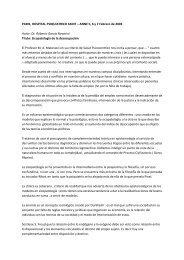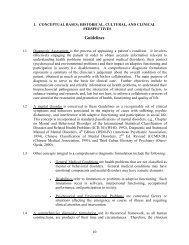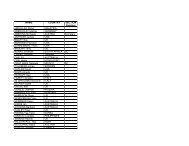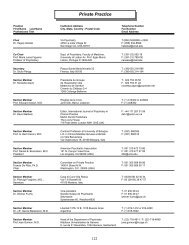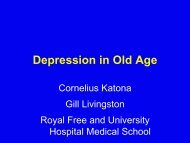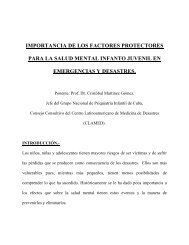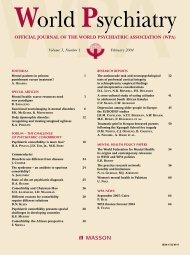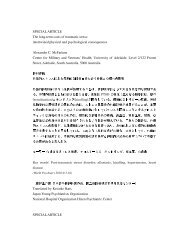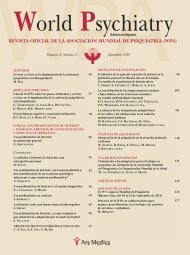ABSTRACTS - World Psychiatric Association
ABSTRACTS - World Psychiatric Association
ABSTRACTS - World Psychiatric Association
Create successful ePaper yourself
Turn your PDF publications into a flip-book with our unique Google optimized e-Paper software.
affective states and to increase interpersonal and social function, all<br />
of which are impaired in BPD in the long term. MBT was initially<br />
shown to be more effective than treatment as usual at reducing the<br />
acute symptoms of BPD in the context of a partial hospital programme<br />
over 18-months treatment and after 36 months follow-up.<br />
Patients from the partial hospital programme have now been followed<br />
up for 8 years after entry into treatment. MBT offered in an outpatient<br />
context has also recently been studied in a randomised controlled<br />
trial. Replication of results is needed and some data from independent<br />
researchers studying MBT are presented.<br />
RS7.3.<br />
TRANSFERENCE-FOCUSED PSYCHOTHERAPY<br />
FOR BORDERLINE PERSONALITY ORGANIZATION:<br />
CLINICAL AND STRUCTURAL CHANGE<br />
M.H. Stone, J.F. Clarkin<br />
Department of Clinical Psychiatry, Columbia College<br />
of Physicians and Surgeons, New York, NY; Weill Medical College<br />
of Cornell University, White Plains, NY, USA<br />
Transference-focused psychotherapy (TFP) is an empirically supported<br />
long-term (1 year) individual treatment for those diagnosed with<br />
borderline personality disorder (BPD). This structured treatment has<br />
been constructed and described utilizing an object relations conception<br />
of the borderline pathology. An object relation consists of a particular<br />
affect state linked to an image of a specific interaction between<br />
the self and another person. Object relations are integrated and hierarchically<br />
organized to form the higher-order structures that motivate<br />
personality and personality functioning. Whereas fully consolidated<br />
identity - subjective experience of a stable and realistic sense of self<br />
and others - is the hallmark of normal personality, identity diffusion is<br />
at the core of severe personality pathology. The focus and target of<br />
treatment for severe personality disorder such as BPD is an in depth<br />
exploration of the patients’ internalized object relations as manifested<br />
in interpersonal behavior between patient and therapist. From this<br />
conceptualization, it is hypothesized that successful treatment of borderline<br />
patients with TFP would result in not only symptom change<br />
(e.g., reduction of depression and anxiety, reduction in suicidal<br />
ideation and behavior), but also conceptions of self and others that are<br />
more positive in affective tone and integrated. Our empirical findings<br />
suggest that TFP results in significant clinical changes, and in positive<br />
changes in the conceptions of self and others, as measured by a reflective<br />
functioning scale obtained from the Adult Attachment Interview.<br />
RS8.<br />
CLASSIFICATION OF PSYCHOSES: ARE DISEASE<br />
SPECTRA AND DIMENSIONS MORE USEFUL<br />
FOR RESEARCH AND TREATMENT PURPOSES<br />
RS8.1.<br />
THE PSYCHOTIC CONTINUUM: FIVE SYNDROMES<br />
REQUIRE TWO BRAIN DIMENSIONS<br />
T.J. Crow, R. Gimenes<br />
Warneford Hospital, Oxford, UK<br />
Since the formulation of the type 1 and type 2 syndrome hypothesis,<br />
there has been continued interest in dimensional approaches to schizophrenia.<br />
But these need to take account also of the continuum concept<br />
that schizophrenia is not a discrete entity. From a review of the literature<br />
on syndromes and precursors, we conclude that five syndromes<br />
(positive, negative, incoherence, depression, mania) are necessary,<br />
and each can be related to the components of language. We<br />
now propose that these syndromes can be understood in terms of the<br />
four quadrants of association cortex that are defined by the cerebral<br />
torque, the bias from right frontal to left occipital across the anteroposterior<br />
axis. The torque constitutes relative thinning of the cortex on<br />
one side compared to the other, an anatomical change that gives directionality<br />
to inter-hemispheric connections and separates thought, the<br />
precursor of speech, from speech production, and meaning from<br />
speech perception. According to this concept, the syndromes of psychosis<br />
are the extremes of variation in brain structure related to the<br />
species faculty for language. This faculty depends upon the language<br />
circuit created by the torque, an anatomical feature that has its genetic<br />
origin in the Homo sapiens speciation event.<br />
RS8.2.<br />
CATEGORICAL VERSUS DIMENSIONAL<br />
DIAGNOSTICS IN PSYCHIATRY<br />
M. Musalek<br />
Anton Proksch Institute, Vienna, Austria<br />
One of the main reasons for the dragging progress in treatment and<br />
research strategies in psychiatry are the differing standpoints of leading<br />
psychiatrists to classify major psychiatric disorders. The analysis<br />
of the historical development of the currently used classification systems<br />
indicates that sticking to established terms and methodologies<br />
more and more develops to an obstacle in research and treatment. In<br />
the light of the development of DSM-V and ICD-11, the urgent question<br />
is raised: can we overcome this dilemma Is the concept of a psychotic<br />
continuum really incompatibly opposed to the concept of different<br />
diseases or is there a not yet known link between them<br />
Should we focus research and treatment better on well defined psychopathological<br />
syndromes than on distinct diagnoses Is the differentiation<br />
of disease spectra and dimensions of more heuristic value<br />
for modern research methodologies than to stick on established disease<br />
entities like bipolar (affective) disorders and schizophrenic disorders<br />
The prerequisites for the development of a new generation of<br />
classification systems are going back to clinical ground and empirical<br />
realities and leaving dogmatic ideation aside.<br />
RS8.3.<br />
CYCLOID PSYCHOSES FILL THE GAP BETWEEN<br />
SCHIZOPHRENIC AND (BIPOLAR) AFFECTIVE<br />
DISORDERS<br />
E.J. Franzek<br />
Bouman Mental Health Care, Rotterdam, The Netherlands<br />
The concept of cycloid psychoses is traced back to the beginning of<br />
the 20th century, and since then many scientists and clinical psychiatrists<br />
have been dealing with these “atypical psychoses”. There is a<br />
body of research showing that cycloid psychoses have a low heritability<br />
and are mainly caused by neurodevelopmental disturbances.<br />
There are no prodromal negative symptoms before the onset of the<br />
disease and there is a liability of developing psychotic symptoms triggered<br />
by stress, life events and stimulating drugs. The onset is acute,<br />
within days or within a few weeks; the course is mostly bipolar, with<br />
depressive and manic features and remittent in the long run. There<br />
are no long lasting positive and negative symptoms. However, after<br />
several psychotic episodes, strategies of coping with stress are often<br />
diminished and little or even normal psychosocial stress situations<br />
can provoke psychotic relapse. Operational criteria to distinguish<br />
cycloid psychoses from schizophrenia and bipolar affective psychoses<br />
are presented. Recent research points out that it is worthwhile to<br />
38 <strong>World</strong> Psychiatry 8:S1 - February 2009




